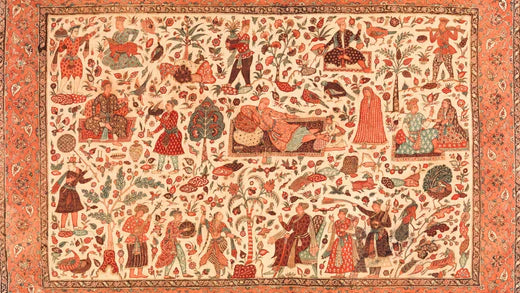What Is Kalamkari And How Is It Done?
The literal meaning of Kalamkari is "pen worked", and the process includes multiple steps to get perfect designs. Kalamkari is basically a kind of hand-printed cotton textile. The art originally emerged in the northern part of India and slowly became popular all across the world. The art involves ancient styles of hand painting, which is one of the reasons why it recently received the Geographical Indication tag.
What Is Kalamkari?

Kalamkari is a type of hand-painted cotton textile that has its roots in the Deccan part of India. Andhra Pradesh and Telangana are the states where Kalamkari paintings are mainly done.
Apart from the cotton fabric, Kalamkari is also done over the silk fabric. The hand paintings are done with a tamarind pen using natural dyes.
The word Kalamkari refers to Craftsmanship which means that it includes unique and detailed techniques.
How Exactly Is Kalamkari Done?

The process of making Kalamkari fabric actually involves 23 steps, and each one is extremely important. The few main steps are bleaching the fabric, softening it, drying it in the sun, getting the natural dyes ready and then air drying and washing.
The fabrics used for making Kalamkari 2 are cotton and silk. The process starts with treating the Kalamkari fabric with a solution of cow dung mixed with bleach. This technique helps the fabric get a solid off-white colour.
The next step is to dip the fabric in a mixture of Buffalo milk and my lobalans so that the dyes do not smudge.
The last step in getting the fabric ready for painting is to wash it twenty times and then leave it to sundry. Once the fabric is dried, Kalamkari designs are then painted on the fabric by hand.
The details in the paintings are mostly based on mythological characters, and the dyes used are all natural.
Types Of Kalamkari
There are two types of Kalamkari: Srikalahasti and Machilipatnam. Srikalahasti style includes Kalamkari designs that are based on Hindu mythology, and in Machilipatnam style, the designs are printed with hand-carved blocks.
Both types are unique and beautiful in their own way. Gujarat and Andhra Pradesh are two states where these two types of Kalamkari are mainly practised.
The Kalamkari designs of Andhra Pradesh are mostly based on forts, palaces, and temples, along with animal and bird motifs. Gujarat takes inspiration from mythological characters to create beautiful Kalamkari designs.
The Bottom Line
Kalamkari art has gone through many transitional phases. It received patronage during the Mughal period, and the British also took an interest in Kalamkari. Even though technology has left a bad impact on this art since the techniques used are tedious, it still hasn't left the market.
There is nothing that can replace Kalamkari. Designers of the Indian fashion industry are also coming together to save this gem. They are helping artisans to practise Kalamkari. This art has come a long way, and it still has to go a long way.


